The AUX I/O connector has two nodes that control this port:
This topic covers the use case for the AUX input signals and has the following sections (For more information—including AUX external signals—refer to Using the Keysight X-Series Signal Generator AUX I/O Port or and to AUX I/O Input/Output Pin-outs and Signals ![]() figure and Table 1):
figure and Table 1):
| AUX I/O Input/Output Pin-outs and Signals for Real-time Signal Studio | |||||||
|---|---|---|---|---|---|---|---|
| Pin Number | Connector Label/Signal | Notes | |||||
| Input | Output | ||||||
| 1 | Marker 1 Signal | ||||||
| 2 | Marker 2 Signal (Playback only) | ||||||
| 3 | Marker 3 Signal | ||||||
| 4 | Marker 4 Signal | ||||||
| 5 | -- | -- | Future Use | ||||
| 6 | AUX Strobe | ||||||
| 7 | 10 MHz Clock | ||||||
| 8 | AUX0 | ||||||
| 9 | AUX1 | ||||||
| 10 | AUX2 | ||||||
| 11 | AUX3 | ||||||
| 12 | AUX4 | ||||||
| 13 | AUX5 | ||||||
| 14 | AUX6 | ||||||
| 15 | AUX7 | ||||||
| 16 | AUX8 | ||||||
| 17 | AUX9 | ||||||
| 18 | AUX10 | ||||||
| 19 | AUX11 | ||||||
| 20 | GND | GND | |||||
| 21 | AUX12 | Future Use | |||||
| 22 | GND | GND | |||||
| 23 | AUX13 | Future Use | |||||
| 24 | GND | GND | |||||
| 25 | AUX14 | Future Use | |||||
| 26 | GND | GND | |||||
| 27 | AUX15 | Future Use | |||||
| 28 | GND | GND | |||||
| 29 | AUX Sample Clock | ||||||
| 30 | GND | GND | |||||
| 31 | AUX out 0 | Future Use | |||||
| 32 | GND | GND | |||||
| 33 | AUX out 1 | Future Use | |||||
| 34 | GND | GND | |||||
| 35 | AUX out 2 | Future Use | |||||
| 36 | GND | GND | |||||
The AUX input signals are used to provide feedback to the real-time signal generation software, such as N7624CSignal Studio for real-time LTE FDD signals.
For the N7624C operation, AUX input signaling can be used to provide timing adjustment and HARQ testing. An external signal is connected to the AUX input port and is used to signal a timing advance (TA) command and ACK/NACK for each subframe.
The AUX input port can be configured in the Signal IO node of the N7624Csoftware. Refer to Figure 1 .
The AUX port has a “Multiplexed” mode and a “Dedicated” mode. Figure 2 indicates that the AUX I/O port is set to “Multiplexed” mode. In Figure 1, notice the 5. Aux Pin/Bit Select parameter area, where the AUX0 pin is selected. This means that the LTE FDD real-time system will expect you to supply a HARQ ACK/NACK signal, using the AUX 0 pin of the AUX I/O connector.
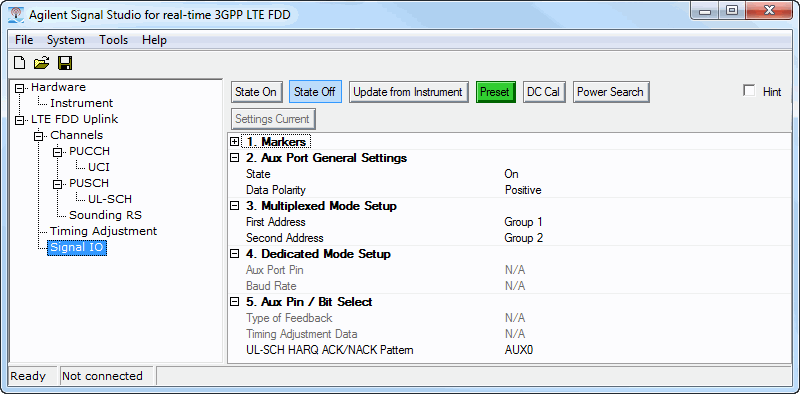
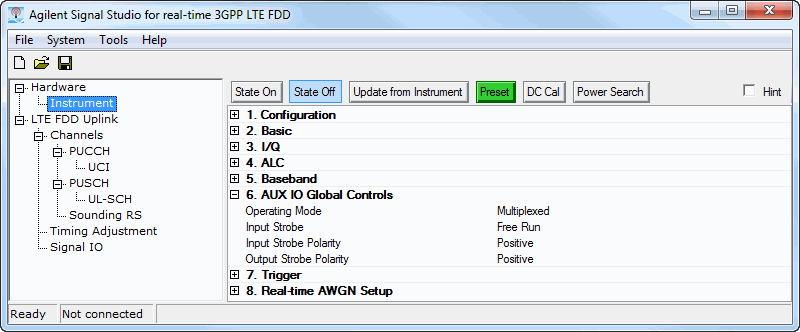
This section describes the Signal IO node, as it relates to the AUX I/O port input signals. The following AUX port settings are displayed in Figure 1. For more information, refer to Signal IO.
| Aux Port General Settings | |
|---|---|
| State |
On or Off — Off means the AUX signaling is ignored |
| Data Polarity | Positive or Negative — Positive means a 3.3-volt signal is interpreted as a ‘1’ and a 0-volt signal is a ‘0’. Negative selection inverts this so that a 3.3-volt signal is interpreted as ‘0’ and 0-volt signal is interpreted as ‘1’. |
| Multiplexed Mode Setup | |
|
In the Instrument node, the AUX IO Global Controls > Operating Mode can be selected as “Multiplexed” or “Dedicated” - in this case it is selected as “Multiplexed”. Refer to Figure 2 or to the MXG/EXG's User Guide (p/n: N5180-90056). |
|
| First Address | For the MXG/EXG it is not necessary to select any Group addresses, so these can be left in their default state. |
| Second Address | For the MXG/EXG it is not necessary to select any Group addresses, so these can be left in their default state. |
Dedicated Mode Setup |
|
|
|
| Aux Port Pin | Because the AUX port mode is selected as “Multiplexed” these settings are not active, and are shown in gray text. When “Dedicated” mode is selected, this field is used to select the AUX pin of the dedicated connection. |
| Baud Rate | Because the AUX port mode is selected as “Multiplexed” these settings are not active, and are shown in gray text. When “Dedicated” mode is selected, this field is used to select the baud rate of the dedicated connection. |
| AUX Pin/Bit Select | |
| Type of Feedback | Sets the bit location of the feedback command type. This parameter is not available when in multiplexed mode. |
| Timing Adjustment Data | Sets the bit position of the timing adjustment feedback. This parameter is not available when in multiplexed mode. |
| UL-SCH HARQ ACK/NACK Pattern | Sets the AUX pin of the multiplexed mode for the UL-SCH HARQ ACK/NACK pattern. |
The AUX port has a “Multiplexed” mode and a “Dedicated” mode. In “Multiplexed” mode, auxiliary signaling is sent using level-sensitive binary signaling (3.3V LV TTL) connected to one or more AUX port input bits. In “Dedicated” mode, auxiliary signaling is sent using an RS232C like serial signal at a specified baud rate to a selected AUX port input bit.
The AUX port mode can be selected in the Instrument node's AUX IO Global Controls > Operating Mode parameter (see Figure 2), by sending a SCPI command, or by using the instrument's front panel. Refer to the MXG/EXG's User Guide (p/n: N5180-90056).
In the Instrument node there are four AUX Port Global controls.
| Operating Mode | Select “Multiplexed” or “Dedicated". These functions as described Signal IO Node AUX Input Parameters. |
| Input Strobe | There are two selections: Free Run or User. In Free Run mode, the instrument samples the values of the AUX input signals (AUX0 ... AUX11), according to the instruments internal timing - this happens at about 3.5 MHz. In User mode, you must supply a strobe signal which causes the AUX input signals to be sampled. |
| Input Strobe Polarity | You can choose Positive or Negative polarity. With positive polarity, the AUX input signals are sampled via the rising edge (0V to 3.3V transition) of a pulse (AUX strobe) supplied by you to the AUX I/O connector pin 6. With a negative polarity the AUX input signals are sampled on the falling edge of AUX strobe. |
| Output Strobe Polarity |
Determines when the AUX input signals have been sampled by looking at the AUX sample clock (connector pin 29) signal. If the Output Strobe Polarity is positive, this will be a positive going pulse (about 200 ns pulse width), which is triggered when the AUX input signals are sampled. If the polarity is negative, the AUX sample clock will be a series of negative going pulses about 200 ns pulse width. |
The Auxiliary I/O port is designed to support your real-time signal generation software configuration with the instrument, and to interface with different configurations of external equipment under test.
For example, consider a sample configuration where you are using LTE FDD uplink signal generation software to control the instrument. The N7624C software can be configured to accept a timing adjustment command and/or HARQ command from external equipment to enable testing of power control loops in base stations.
Auxiliary signaling can be delivered from external equipment in one of two formats.
If this signal cannot be delivered directly from the external equipment, an inexpensive interface board can be used to connect to external equipment with a USB connection, for example the USB Bit Whacker (SKU: DEV-00762, www.sparkfun.com), can be used to interface from your external equipment with a USB connection to the Keysight Auxiliary I/O port.
Figure 3. Serial Data Transmission Format-Polarity is Positive (Default)

Figure 4. Polarity is Positive - Hex Example
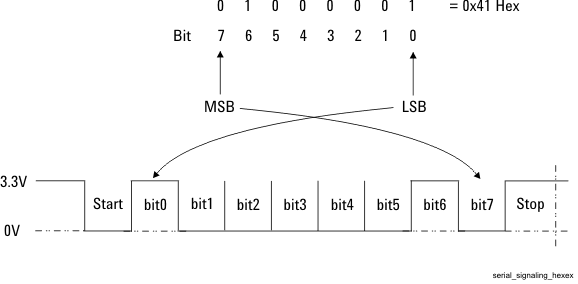
Figure 5. Serial Data Transmission Format-Polarity is Inverted

Again, using the LTE FDD example in AUX I/O Port: Input Signaling. In this example, the instrument's LTE FDD can accept HARQ ACK/NACK feedback and or Timing Adjustment feedback. Figure 6 shows a typical interconnect diagram with an LTE FDD base station for purposes of doing base station receiver test. In this example:
Figure 6. LTE FDD Base Station Receiver Testing Connections
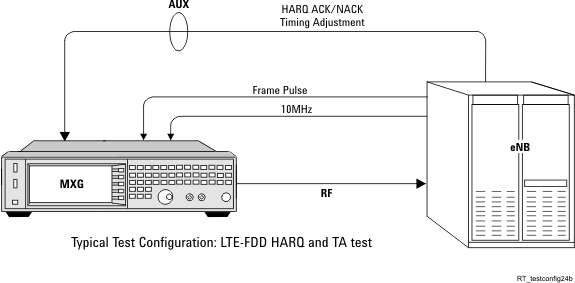
The availability of HARQ and timing advance (TA) functions are depending on the AUX operating mode (i.e. Dedicated or Multiplexed). In the Multiplexed mode, HARQ ACK/NACK feedback is functional. In the Dedicated mode, HARQ ACK/NACK feedback and Timing Adjustment feedback are functional. In both modes, the external device must provide the signal for every subframe.
The single line's signaling format can be selected as Multiplexed or Dedicated. The instrument's interface enables selection of the signaling format by pressing the following keys:
Mode > Real-Time Applications > Real-Time Apps System Settings > AUX Port Setup > Operating Mode > Dedicated or Multiplexed
The instrument's AUX pins, AUX0 to AUX11, are available for delivering auxiliary commands from 1- to 12-bits in width in Multiplexed mode.
In Dedicated mode, where serial format signaling is used, serial signaling can be connected to any one of the pins AUX0 to AUX11.
In Dedicated mode, all signaling is delivered in the serial format as in AUX I/O Port:Input Signaling. Serial command signals can be connected to the AUX0 to AUX11 pins of the AUX I/O connector. The serial format transmits 8-bits at a time to the instrument. These bits can be mapped to the auxiliary signaling functions of Signal Studio's real-time signal generation software.
For the LTE FDD HARQ and timing advance (TA) commands, bit7 and bit6 are always assigned to the “Type of feedback” signal. If the signal is “00”, bit5 to bit0 are recognized as a TA command. If bit7 and 6 are “01”, bit 1 to bit 0 are recognized as a HARQ ACK/NACK command. See Figure 7.
Figure 7. Dedicated Format Transmits 8 Serial Bits
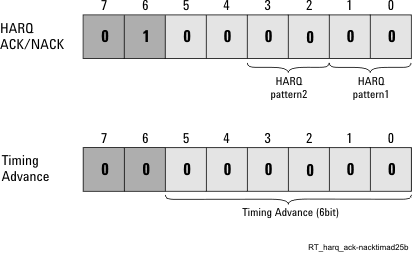
The HARQ command uses two bits of the serial data, bit1 and bit 0. Bit1 is reserved and bit0 contains the ACK (1) or NACK (0). This means that LTE FDD uses only the HARQ pattern1 identified in Figure 7 above, HARQ ACK/NACK. When the software controls multiple instruments, the reserved bit is sent over one antenna port and the ACK/NACK bit over the other.
The timing advance(TA) command has 6-bits, the value range is 0 to 63, which is defined as TA, in the 3GPP STD TS36.213 4.2.3 Transmission timing adjustments section.
In Multiplexed mode, auxiliary commands are delivered as 1- to 12-bit wide commands in LV TTL format.
For the LTE FDD HARQ command, you can select the signal line as AUX0 to AUX11.
Keysight X-Series Signal Generator's User Guide (p/n: n5180-90056)